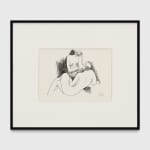Julio González
Further images
Julio González's Deux femmes (1936) stands as a testament to the artist's dexterity with pencil and ink, demonstrating how his drawing skills underpin his transformative work in iron sculpture. González, a pioneer in the realm of 20th-century sculpture, introduced the radical concept of "drawing in space," where lines of metal became akin to strokes on paper. This approach, deeply rooted in his prowess as a draftsman, allowed him to infuse his sculptures with a sense of fluidity and dynamism previously unseen in the medium. In Deux femmes, the meticulous cross-hatching and delicate line work reveal the same precision and sensitivity that would later manifest in his metal sculptures, bridging the gap between two-dimensional and three-dimensional forms.
The composition of Deux femmes exudes a classical elegance reminiscent of Greco-Roman art, yet it is executed with a modern sensibility that breathes new life into its traditional subject matter. The reclining figures, rendered with an economy of line and a nuanced understanding of human anatomy, evoke the timeless beauty of ancient sculptures. However, González's modern execution, characterized by its bold simplicity and expressive contours, contrasts sharply with the classical inspiration, highlighting the artist's ability to blend historical references with contemporary techniques. This juxtaposition of the classical and the modern underscores González's innovative spirit and his ability to transcend temporal boundaries in his art.
Set against the vibrant backdrop of 1930s Paris, Deux femmes reflects the era's renewed interest in drawing and works on paper, which modern artists increasingly viewed as complete works in their own right rather than mere preparatory studies. In this milieu, González's drawings gained prominence, showcasing the diversity of his artistic language. During the 1930s, his work ranged from figurative classicism, as seen in Deux femmes, to compositions resolved through the syntax of Cubism. This versatility not only illustrates his adaptability and openness to various artistic influences but also situates his practice within the broader narrative of modern art. González's Deux femmes is a poignant reminder of the power of drawing, both as a foundational skill and as a medium for artistic exploration and expression, embodying the rich interplay between tradition and innovation that defined González's illustrious career.
NOTES
This drawing is signed with the artist's initials and dated 1936 on the lower right corner.
We extend our gratitude to M. Philippe Grimminger and Ms. Amanda Herold from the Julio González Administration in Paris for their invaluable assistance in cataloguing this artwork.
Provenance
The artistRoberta González, Paris, France
Carmen Martínez and Viviane Grimminger, Paris, France
Private collection
Exhibitions
Paris, France, Galerie de France, Julio González. Dessins inédits, March - May 1993, cat. no. 58.Lugano, Switzerland, Galerie Pieter Coray, Julio González: Disegni inediti, September 9th - November 13th, 1993, cat. no. 64.






